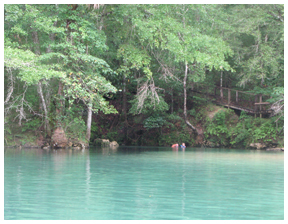
Not only our most valuable water sources, spring fed waterways provide extraordinary adventure
Some of the most beautiful places to explore Northwest Florida are along our spring fed waterways. These creeks, streams and rivers provide incredible recreation and eco tourism along with the valuable drinking water our communities rely on.
Florida boasts more than 700 springs, with close to 40 in the Walton, Holmes, Washington and Bay counties. Blue Spring and Jackson spring in Holmes County feeds into the Choctawhatchee River and is Florida’s 12th largest spring with 122 million gallons per day discharge. Holmes Creek has more than a dozen springs and is the largest tributary into the Choctawhatchee River. The Gainer Springs Group on Econfina Creek (including springs locally known as McCormick and Emerald) is the most significant, measuring a first magnitude flow of 114 million gallons a day (mgd). Econfina creek feeds into Deer Point Lake which is the major source of water supply for Bay County.
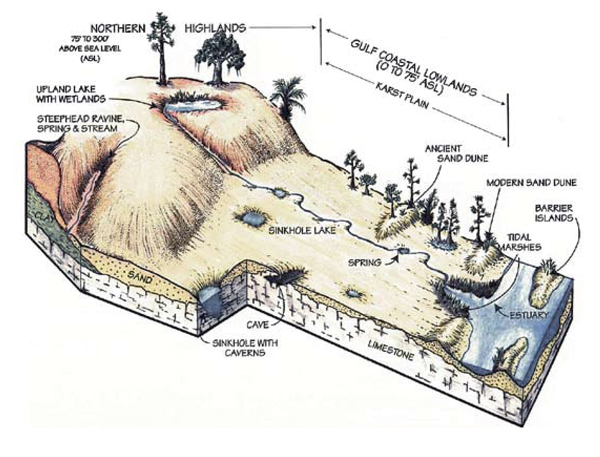
What are springs?
Springs are portals where water in the earth’s aquifers, rises to the surface and escapes into our streams, lakes and coastal waters. There are two general types of springs in Florida, seeps (water-table springs) and karst springs (artesian springs). The springs in Northwest Florida are karst springs. Karst topography is a landscape created by groundwater dissolving into sedimentary rock such as limestone. This creates landforms such as shafts, tunnels, caves, and sinkholes. The Dougherty Karst Plain underlies our area.
What is a spring classification?
Springs are most often classified based upon the average discharge of water. Individual springs exhibit variable discharge depending upon rainfall, recharge and groundwater withdrawals within their recharge areas. One discharge measurement is enough to place a spring into one of the eight magnitude categories. However, springs have dynamic flows. A spring categorized as being a first-magnitude spring at one moment in time may not continue to remain in the same category. This can result in a spring being classified as a first magnitude spring at one point in time and a second magnitude at another.
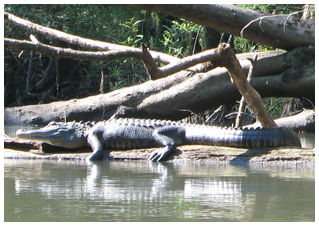
What will I find exploring a spring and a spring fed waterway?
These beautiful waterways of Northwest Florida are abundant with fish and plant life.
Here is a list of the most common things you will find:
Fish:
Largemouth bass, spotted bass, bluegill, sunfish (shellcracker), redbreast sunfish, warmouth, black crappie, striped bass, catfish, alligator gar, bowfin.
Invertebrates:
Florida Apple snail, freshwater mussel, pond crayfish, six-spotted fishing spider, mayfly, diving beetle, giant waterbug, dragonfly, damselfly, mosquito, biting fly, butterfly.
Reptiles:
Florida green water snake, cottonmouth/water moccasin, Florida snapping turtle, American alligator, salamanders, newts, treefrogs.
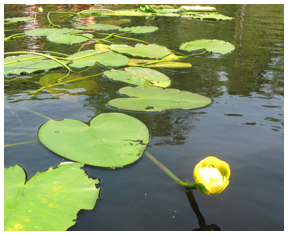
Mammals:
Gray squirrel, river otter, beaver, raccoon
Birds:
Wood duck, mottled duck, great blue heron, great white heron, green heron, ibis, swallow-tailed kite, bald eagle, hawk, owls, osprey, kingfisher, warbler, scarlet tanager.
Trees/Plants/Grasses:
Bald cypress, live oak, red maple, pawpaw, black titi, red titi, Cherokee bean, sweetbay, blackgum, juniper, red cedar, southern magnolia, laurel oak, tupelo, hickory, willow, wax myrtle, cabbage palm, saw palmetto blueberry, hydrangea, St. John’s wort, mountain laurel, water lily, pickerelweed, pitcher plant, broad leaved arrowhead, fern, moss
Where can I find a spring fed waterways to explore?
There are almost endless possibilities of places to explore in a kayak or a canoe. Here are four of the best places to launch or rent a kayak or canoe, or enjoy swimming in the cool water of a spring fed wateray.
Here is a Lat. Lon listing of springs in Walton, Holmes , Washington and Bay counties: springlocationlist
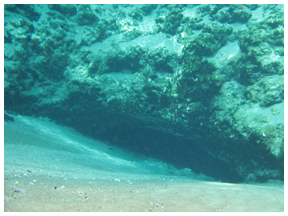
Econfina Creek in Washington and Bay County
Part of Florida’s Greenways and Trails, the Econfina Creek in Bay and Washington counties is many a paddlers’ favorite journey in the Florida Panhandle.
Pack a lunch and bring your snorkel, for you are about the enjoy the paddle of a lifetime as you explore the creek and its many crystal clear springs along the popular seven-mile trip down the creek. Cabbage palms drape over the water’s edge along with blooming wildflowers scattering the banks with color during your journey in the spring and summer months. Steep, fern-covered limestone walls prevail along the second half of the paddle, where the creek slices into the ancient limestone of the Floridan Aquifer.
The northern portions of the creek are difficult with many logjams and shallow water. Most paddlers opt to put in at the Econfina Livery as the livery offers the option of pick up and return at the take out at SR 388 bridge. They also have kayaks and canoes available for rent.
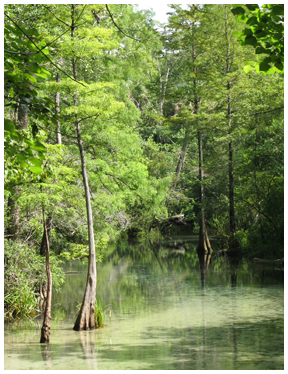
The Econfina Creek is largely preserved and managed by the Northwest Florida Water Management District, and part of the much larger 41,000 acre Econfina Creek Water Management Recreation Area. The Recreation Area offers camping, hiking along the Florida Scenic Trail, boating, fishing and equestrian trails along with campsites and recreational parks.
The District has identified 11 springs or spring groups comprised of 39 individual vents, most of them within a mile of State Road 20.
There are several places to launch a canoe or kayak:
• Scott’s Bridge – From US 231 four miles north of Fountain, take Scott’s Road west four miles to bridge. (This is the upper portion of the creek and for skilled paddlers only as there are many portages due to log jams)
• Walsingham Bridge – From SR 20 turn north on Strickland Road which becomes Porter Pond Road. There is a fence line on the right side of the road. Follow the fence line and make the two right turns where the fence turns. Take Washington Bridge Road to the bridge.
• Econfina Canoe Livery – One mile north of SR 20 on Strickland Road. Eight miles east of Hwy. 77, offers both canoes and kayaks for rent along with a shuttle back to your vehicle after your paddle. Call 850-722-9032 for more information.
• SR 20 Bridge – (1 mile) limited parking.
• SR 388 Bridge – (6 miles)
Holmes Creek in Washington County
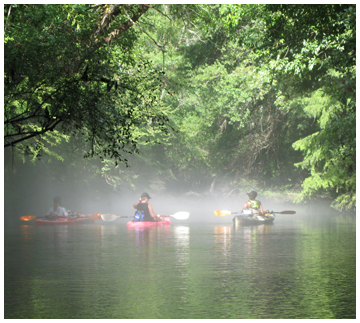
As part of Florida’s statewide system of Greenways and Trails, Holmes Creek flows through a variety of diverse habitats. The upper and lower portions pass high sandy banks while the majority of the tail is through low-lying swamplands.
Rich with flora and fauna, the creek is abundant with turtles and birds, including blue, green and white heron, ibis, warblers and woodpeckers.
Several sections of the creek are shallow and clear. Underwater plants seem alive with movement as they ripple under the water’s surface. Water lilies are in abundance, and on this mid-summer day, were just starting to bloom.
Bird and wasp nests dangled from the trees seemed almost as though suspended in air as you looked above towards the treetop’s canopies.
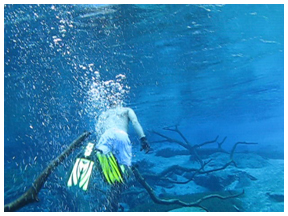
There are several crystal clear springs, including Cypress Springs, which flows at 89 million gallons per day and Becton Springs, which flows at 40 million gallons per day, that feed the creek. There is a smaller spring at the Brunson landing where you can pull in, take a short walk along a wooded trail and find the small spring approximately 35 ft. in diameter.
Bring your snorkeling gear, as a dive into Cypress Springs is one of the highlights of the paddle offering you the opportunity to get up close and personal with a beautiful spring boil.
The creek has many low-hanging branches and submerged tree trunks, which can present a small, but not difficult challenge. For the most part, the gentle curves and a slow current make Holmes Creek an easy paddle through beautiful hardwood swamps.
Launches:
A. Cotton Landing: 3 miles north of Vernon on CR 277. This managed by Northwest Water Management District with primitive camping allowed. There is a small pavilion with tables, a portable toilet, fire ring, and area for tents or trailers. It is down a 1 mile gravel road from County Hwy. 278.
One mile downstream, the Cypress Springs run is on the right, paddle a short distance upstream to a swim and snorkel in a Magnitude 2 spring. The land is privately owned, but allows boaters access as long as visitors keep the area clean.
B. Culpepper Landing: Travel north on CR 277 for 2 miles to a Washington County Boat Ramp. Put your boat in here and paddle upstream for less than a mile, and then up the Cypress Springs run. After playing in the cold, clear water, you can go back to the Culpepper Landing and take-out, or continue two miles downstream to the Vernon Boat Ramp, or chose the longer paddle to Hightower Springs Landing.
Map locations:
1. Canoe Livery service for Holmes Creek:
Holmes Creek Canoe Livery
Located at SR 79 just North of the Vernon bridge.
To find it, drive into the Vernon Park and boat landing
Kayaks and aluminum tandem canoes rentals
The livery provides shuttle service for $15 for those with their own boat.
850-210-7001
2. Brunson Landing: Turn left on CR 278 immediately before the bridge, travel two miles, and turn L on Dorch Circle, and again left on Bronson Landing Road. This is a more primitive landing than Fanning Branch or Hightower. No facilities were available.
3. Hightower Springs Landing: This is a take out option for your paddle. There is a small springs with a pond on the left side of the landing. Local people say they swim in the spring, but the banks were swampy and the edges mucky to wade out into the water. There are picnic tables, grills, and a portable restroom.
4. Take-out: Live Oak Landing
Directions to take-out: From Vernon travel south on SR 79 to junction of SR 284, turn right (west)
and drive about 1.3 miles to Hancock Rd. Turn right on Hancock Rd. and go 1 mile to Live Oak Landing
Rd. Turn left on Live Oak Landing Road and drive about 0.5 miles to public boat ramp
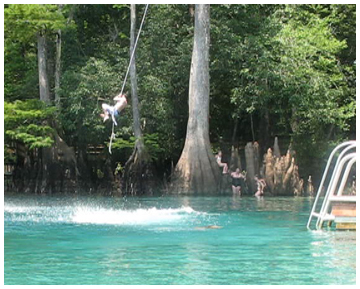
Morrison Springs in Walton County
Just south of Ponce De Leon, the 161-acre park is well known in the area, and popular with divers and nature enthusiasts across the south. Cypress trees abound around the spring with their crisp, bright green needles defining the landscape. The spring provides an aqua color inviting everyone in for a dip.
The highlight of the park is a 250-foot diameter spring pool that produces an estimated 48 million gallons of crystal clear water each day and has been recorded to produce up to 70 million gallons a day. Three cavities allow Morrison’s frigid waters to surface from the underground aquifer. The deepest of these cavities, at approximately 300 foot in depth, eventually terminates in an underground chamber of unknown dimensions. Morrison Springs is a favorite of divers.
Recently completed renovations include approximately 575 linear ft. of boardwalks meandering through the ancient cypress trees, and span into the springs to a diver’s launching area, with a 10×10 ft. 9,000 lb. floating concrete platform.
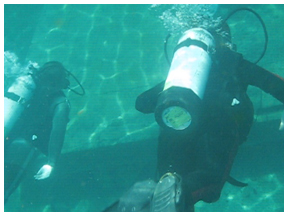
Restroom facilities, a pavilion with picnic area, wash stations, showers and handicap access are available at the park now, offering it the perfect family destination.
There are 72 parking spaces at the entrance to the park, which include 10 bus and 4 handicap spaces. There are 24 boat/trailer spaces located at the boat ramp.
The park was acquired by the state in 2004 and its management is now entrusted to Walton County for 99 years. The project is also part of the ‘DEP Springs Initiative;’ a comprehensive protection effort which provides funding for springs restoration throughout the state of Florida.
Directions:
Morrison Springs is located in the most southeastern part of Ponce deLeon just inside the Walton County line. From Freeport, take State Road 20 east to State Road 81 and go north past Red Bay to County Highway 181C. Turn right and continue 1.6 miles. Turn a right on Morrison Springs Road.
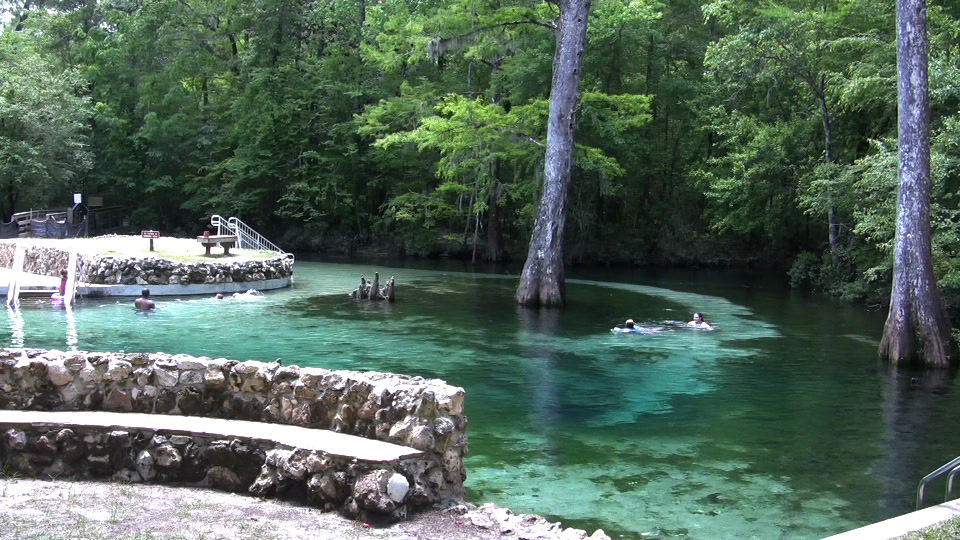
Ponce deLeon Springs in Holmes County
Just outside the Walton County line is one of the coolest places to take a dip in a spring, Ponce de Leon Springs State Park. As the water stays a constant 68 degrees Fahrenheit year-round, both locals and visitors enjoy this nature-made swimming pool, which is a convergence of two underground water flows, producing 14 million gallons of water daily.
The main vent is centrally located in the pool at a depth of 16 feet and is about 9 feet in diameter. A second vent about 10 feet from the north bank is a circular chimney 6 to 8 feet in diameter with a depth of 16 feet. A few feet from the north bank near the spring-run is a third vent. The aquatic cave habitat has been greatly improved because of recent efforts to remove organic sediments and debris that had previously blocked the vents. The park’s aquatic cave is likely home to cave crayfish.
This beautiful spring is named for Juan Ponce de Leon, who led the first Spanish expedition to Florida in 1513 – as legend has it, in search of the “fountain of youth.”
The park has a long history as it has been facilitated as far back as the early 1900s, and at one time, offered a roller skating rink. The State acquired the springs in 1970.
The spring area boasts an open pool with easy access steps entering the water. The crystal clear water shows bream and bass swimming around below.
Visitors can take a leisurely walk along two self-guided nature trails through a lush, hardwood forest and learn about the local ecology and wildlife. The walk offers a closer look at Sandy Creek, where the springs empties into, and eventually leads to the Choctawhatchee River.
Local flora includes mountain laurel, magnolias, cypress, holly, cedar and oak trees. Snakes, fox, and lizards are a common sight in the area as well.
There are four pavilions offering grills and picnic tables. There are several more tables and grills scattered around the park offering the perfect place to hold a family picnic. Rangers also conduct seasonal guided walks, and anglers can enjoy fishing for catfish, largemouth bass, chain pickerel and panfish.
Hours of Operation
8:00 a.m. to sunset
Driving Directions
Ponce de Leon Springs State Park Area is located one half mile south of U.S. 90 on C.R. 181A in Ponce de Leon, Fla.
Park Fees
Admission Fee – $4.00 per vehicle.
Pedestrians, bicyclists, extra passengers, passengers in vehicles with holder of annual individual entrance permit – $2.00
Ponce de Leon Springs State Park
2860 Ponce de Leon Springs Road
Ponce de Leon, Florida 32455
Phone: 850-836-4281

Trish Becton Hildreth
August 11, 2010In researching the Becton family history of Alabama we discovered that some of our relatives were in Florida a few generations back. I’m wondering if you know where we can find some information about Becton Springs and how it came to have that name?
Trish
September 20, 2010This is cool, i just happen to google my name to see if any of my events were online and i see that we have the same name .. 🙂 I never heard about Becton springs but i will be sure to find out about it. My family as far as i know comes from beaufort north carolina or coastal nc.. my email is trishbecton@aol.com